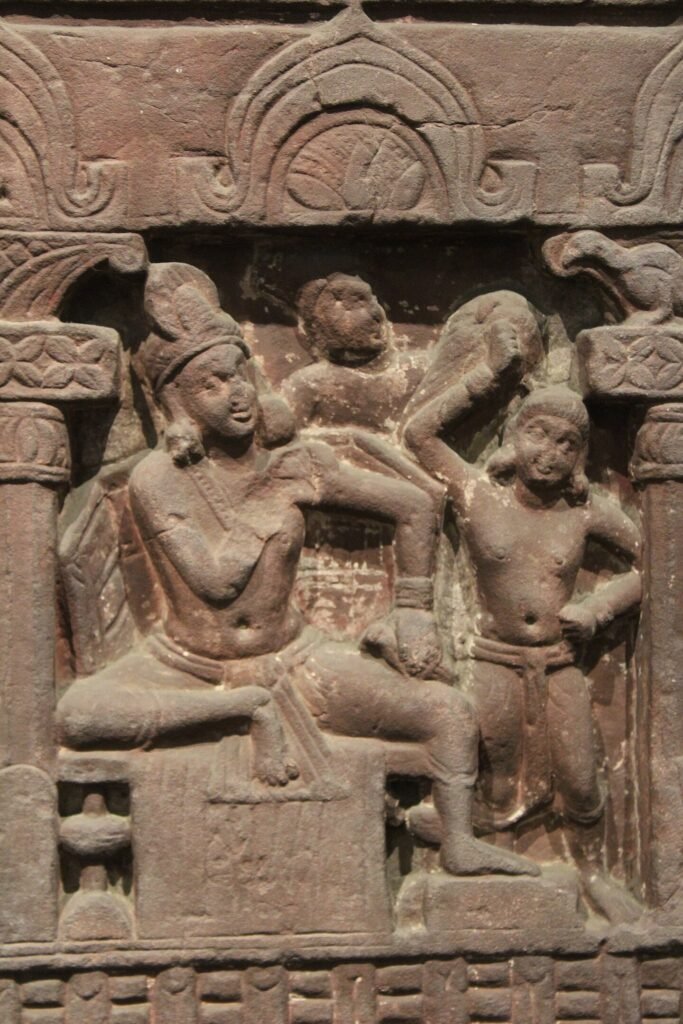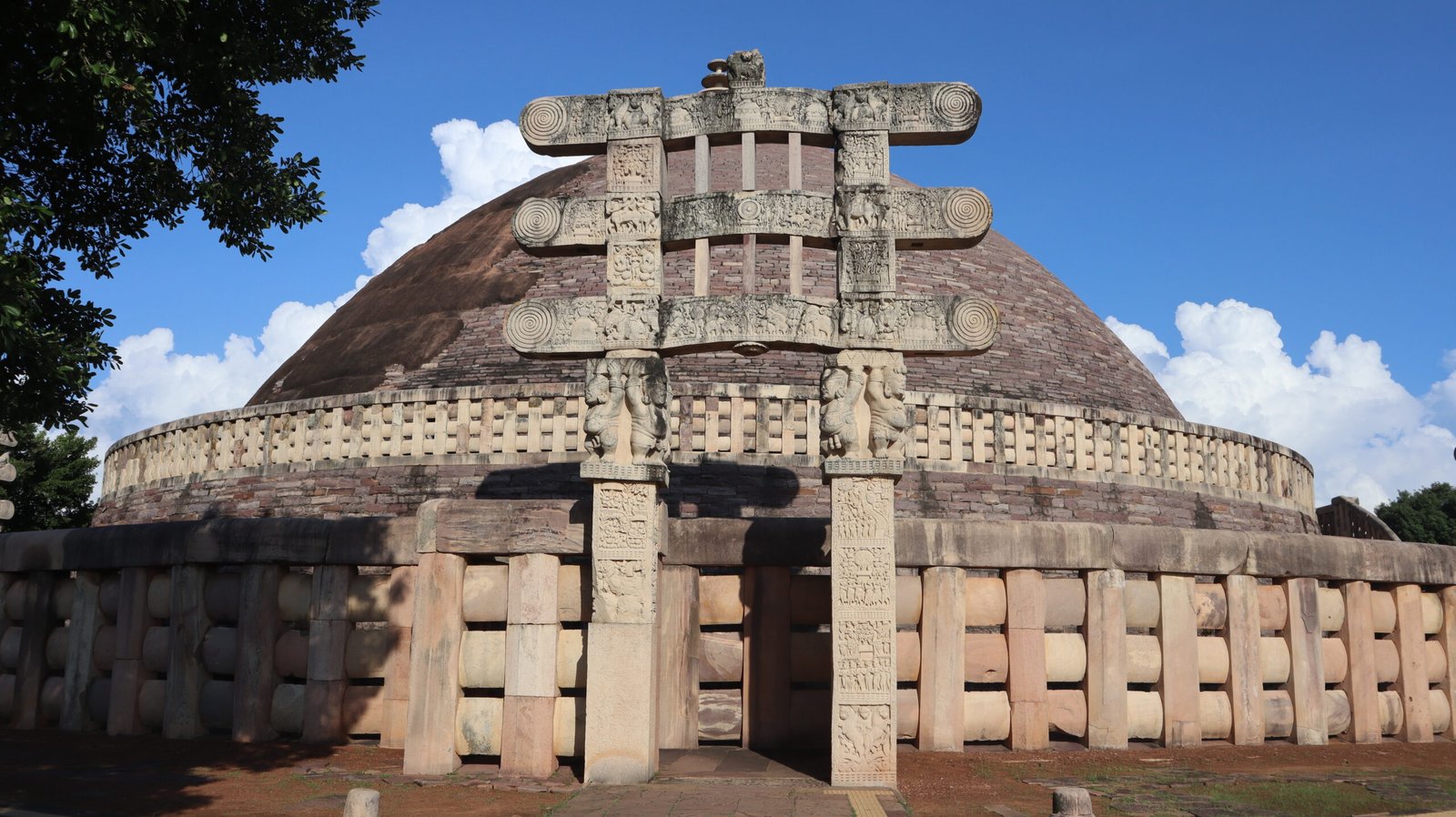Impact of external influence can be seen in Cultural Development In The Post Mauryan Period as well as we have more Buddhist information . Rock-Cut Caves of this period .
we are getting three architectural types
- Apsidal Vault-roof Chaitya Halls:- Found at Ajanta, Pitalkhora, Bhaja;
- Apsidal Vault-roof pillar less Hall:- Found at Thana-Nadsur in Maharastra.
- Flat-roofed Quadrangular Hall:- Having a circular chamber at the back (found at Kondivita in Maharastra).
The Chaitya Hall has a cross-sectional layout with unique architectural components.
The nave is where devotees gather for prayers, while the aisle serves as a designated prayer path. The apse at the cave’s semi-circular end is a distinctive architectural element.
The exterior of the cave is decorated with animal figures and semidivine creatures. During the post-Mauryan period, two types of caves emerged: western and eastern. Western caves were largely Buddhist, whereas eastern caverns, such as Udayagiri and Khandagiri, exhibited Jaina traits. Udayagiri has 18 caves, whereas Khandagiri has 15. Both are notable Jaina cave complexes.
Stupa Architecture in Post Mauryan Period
During the post-Mauryan period, stupa design evolved to include larger and more ornate structures known as “Maha Stupas.” During this era, stone was used extensively in stupa construction, which improved durability and elaborate craftsmanship.
During the post-Mauryan period, stupas grew in size and included intricate toranas. These toranas, with more embellishment and size than earlier stupas, had a significant impact on the architectural environment.
During this period, stupas in Sanchi, Bharhut, Amravati, Nagarjuna, and Bhatti Prolu were known for their architectural splendor. The paintings of Jataka stories on the stupa walls add to its artistic and theological value.
Post Mauryan period – sculptural art
We have three schools of sculptural art
a. Gandhar School of Sculptural Art.
b. Mathura school of sculptural art.
c. Amravati school of sculptural art.
Gandhar school of sculptural art
During the Kushana Empire’s dominance in ancient India, the Gandhar School of sculptural sculpture flourished in the Gandhara region, which now includes Pakistan and Afghanistan, with a focus on Buddhist themes. It began in the 1st century CE and reached its peak between the 2nd and 3rd centuries CE.
The Gandhar School, influenced by Hellenistic and Roman art, depicted Buddha with Greek god-like attributes, including curling hair and a serene, spiritual appearance. Roman art had an impact on the Buddha’s image, resulting in its youthful aspect and imperial grandeur.
The Gandhar School thrived during the Kushana era, with significant centers in Jalalabad, Hadda, Bimaran, Begram, and Taxila. The school’s sculptures were distinguished by their use of grey slate, creating crisp features and anatomical precision.
The Gandhar School’s sculptures depicted Buddhist narratives in a naturalistic and realistic manner. These artworks portrayed human figures with dynamic movement and grace, incorporating drapery and rich decoration to create a lifelike aspect. Among its creations is the legendary “Fasting Siddhartha,” a standing Buddha statue known for its careful details, including flowing robes, delicately drawn hair, and the Buddha’s tranquil look.
As a pivotal contributor to the evolution of Buddhist art in India, the Gandhar School
left a lasting imprint on subsequent artistic traditions in the region, showcasing the
influence of diverse cultural exchanges along the Silk Road.
Mathura School of Art

The Mathura School of Art was prominent in ancient India, notably in Uttar Pradesh, due to its indigenous nature and lack of external influences. This school thrived throughout the Kushan Empire (1st-3rd century CE) and focused on topics from Hinduism, Buddhism, and Jainism.
The Mathura School of Art created sculptures with a unique style and symbolism, combining Indian and Greco-Roman elements. Hindu and Buddhist mythology, including deities like Vishnu, Shiva, and Buddha, were frequently depicted in the artwork. Images of Jain were unearthed at Kankali Tila, Kushana Kings in Mat village, and Yaksha and Yakshini in Mathura.
The Mathura School of Art was known for its use of red sandstone as the major sculptural media. The sculptures were notable for their bright and energetic style, highlighting the physicality and vitality of the depicted individuals. The painters effectively depicted characters’ feelings and attitudes, creating a lively atmosphere.
The Mathura School of Art had a significant impact on Indian art, particularly the depiction of deities and religious narratives, and continues to influence regional artistic traditions today. The area’s art and sculpture continue to reflect its significant impact on ancient Indian culture and art.
Deities depicted on the coins of the Kushanas

The Kushanas, an ancient Central Asian dynasty that ruled a wide empire from the 1st to 3rd centuries CE, issued coins with various images of deities. The Kushanas supported Buddhism and assimilated local traditions, and their coinage represented this diversity in religious iconography.
Shiva is a famous Hindu deity seen on Kushana coins. Shiva, the Hindu god of destruction and transformation, was often represented as Nataraja, the cosmic dancer, or reclining with his bride Parvati. These coins also featured Kartikeya, the Hindu god of fighting and triumph.
In addition to Hindu deities, Kushana coins had Buddhist figures. The Buddha, often represented in seated or standing positions with symbols such as the wheel of dharma or Bodhi tree, was a popular topic. Kushana coins featured several Buddhist deities, including Avalokiteshvara, Maitreya, and protecting deities.
It’s noteworthy that the depiction of deities on Kushana coins varied across different
regions and evolved over time within their empire. The coins serve as invaluable
artifacts offering insights into the religious and cultural tapestry of the Kushana period,
showcasing a blend of foreign influences such as the depiction of the Greek god Heracles,
the Iranian god Nana, and the Brahmanical god Shiva. This eclectic approach indicates
a lack of dominance by any particular religion, reflecting the multicultural nature of
the Kushana empire.
Amravati school of art
During the Satavahana period (2nd century BCE-3rd century CE), the Amravati School of Art flourished in the Amaravati region of modern-day Andhra Pradesh, India, with a distinguished sculptural heritage.
The Amravati School of Art constructed sculptures with a focus on Buddhist themes and tales, known for their exquisite attention to detail and use of white marble. The institution was known for its emphasis on narrative storytelling. Sculptures showed scenes from the Buddha’s life, Jataka tales about prior incarnations, and Buddhist mythology and teachings. The artists were great at depicting emotions and expressions, capturing moments of enlightenment, compassion, and peace.
Amravati sculptures stand out for their dynamic composition and strong relief carving. Figures took gained a three-dimensional appearance, frequently depicting beautiful positions and motions. The statues were embellished with delicate ornamentation and elaborate features, creating a feeling of richness and complexity.
The Amravati School of Art had a profound impact on the development of Buddhist art in India. Its distinct style and iconography influenced neighboring regions, including Nagarjunakonda, Goli, Ghantasala, and Sanchi, demonstrating its lasting imprint on the creative environment.
Gupta Period
During the Gupta dynasty, artistic pursuits like stupa construction, cave architecture, sculpture crafting, and pillar manufacturing continued. Temple architecture, particularly in the Nagara style, became a prominent element alongside the introduction of murals, including moral paintings in caves.
The Dhamek Stupa in Sarnath is an example of a thriving stupa-making tradition. Notable examples of cave building include Madhya Pradesh’s Ajanta and Bagh caves. Pillar construction continued, with famous examples including the Mehrauli and Prayag pillars.
Sculpture flourished in various schools, including Gandhar, Mathura, Amaravati, and Sarnath School of Sculpture. Gupta period sculptures portray Sheshashayi Vishnu, Pandava and Draupadi, Ganga and Yamuna, Shiva and Parvati, and Krishna. Standing Buddha sculptures were prominent, particularly in Sarnath (Uttar Pradesh) and Sultanganj (Bihar).
The Gupta period is known for its unique mural paintings, particularly in the Buddhist art of Ajanta and Bagh. Mural painting flourished during this era, with 29 caves in Ajanta featuring elaborate artwork. The Rangmahal cave in the Bagh caverns complex is known for its mural paintings.
Apart from the visual evidence in sites like Ajanta and Bagh, important texts such as
the Kamasutra and Mudrarakshasa provide insights into the art of painting during this
period. These texts elucidate the six limbs or Sadanga of painting, offering a
comprehensive understanding of the principles guiding this artistic tradition in the
Gupta era.
Pre & Mains : Buy History NCERT 11th class by R.S.Sharma for UPSC
History Optional : Buy A History of Ancient And Early Medieval India : From the Stone Age to the 12th Century By Upinder Singh
Featured Image Credit and License :- Wikimedia Commons license
Inline Image Credit and License :- Wikimedia Commons license
Inline Image Credit and License :- Wikimedia Commons license
